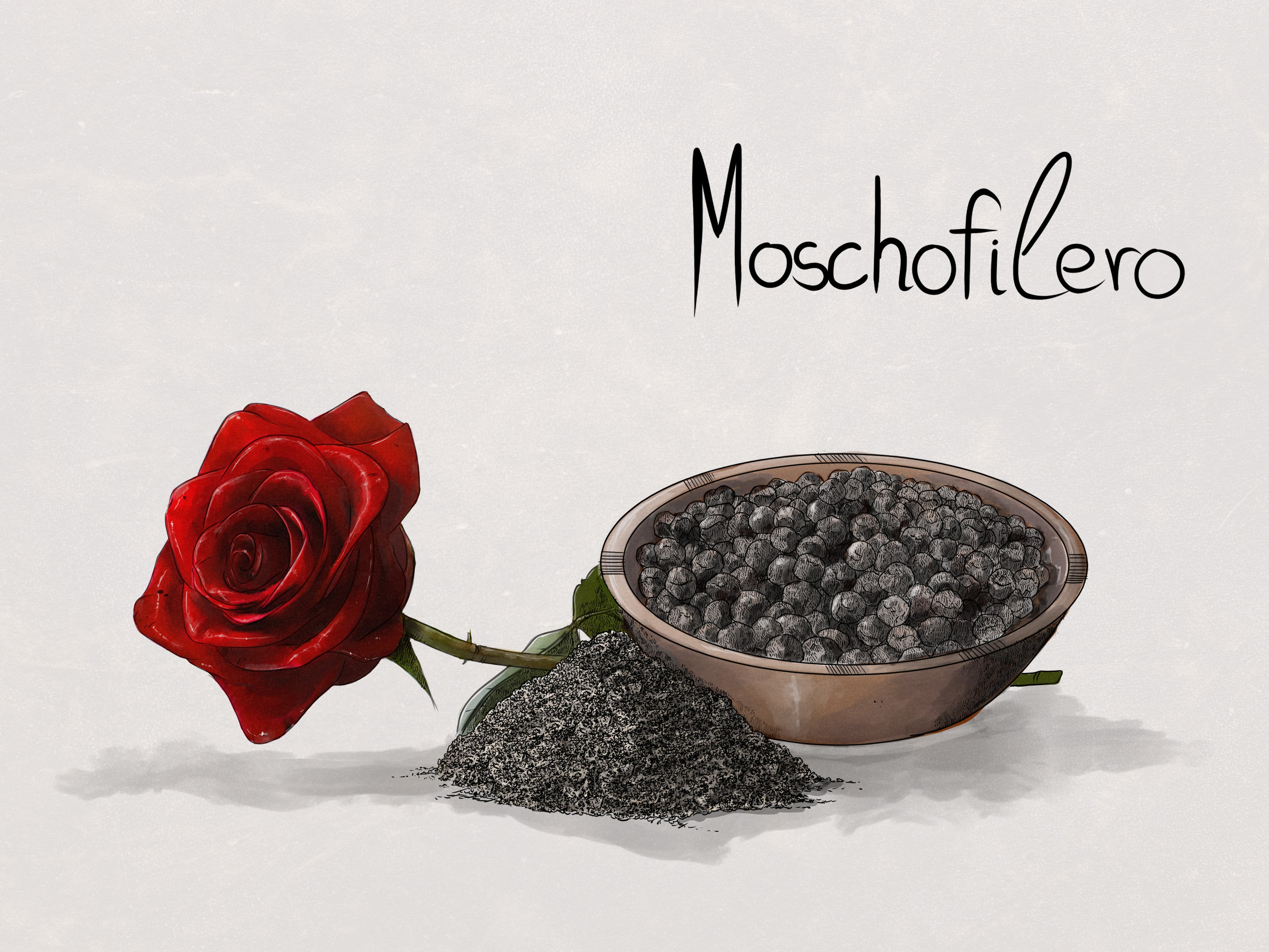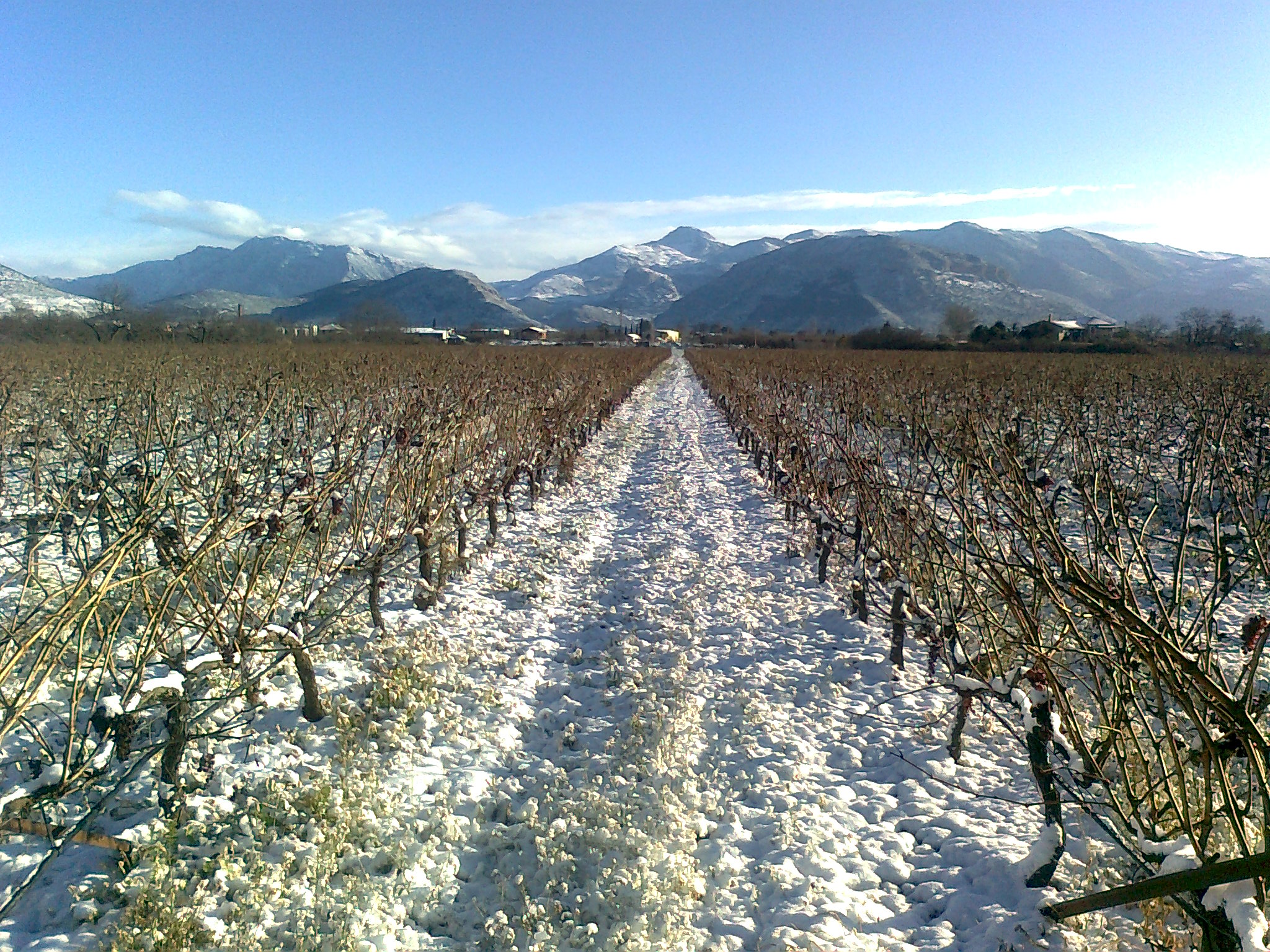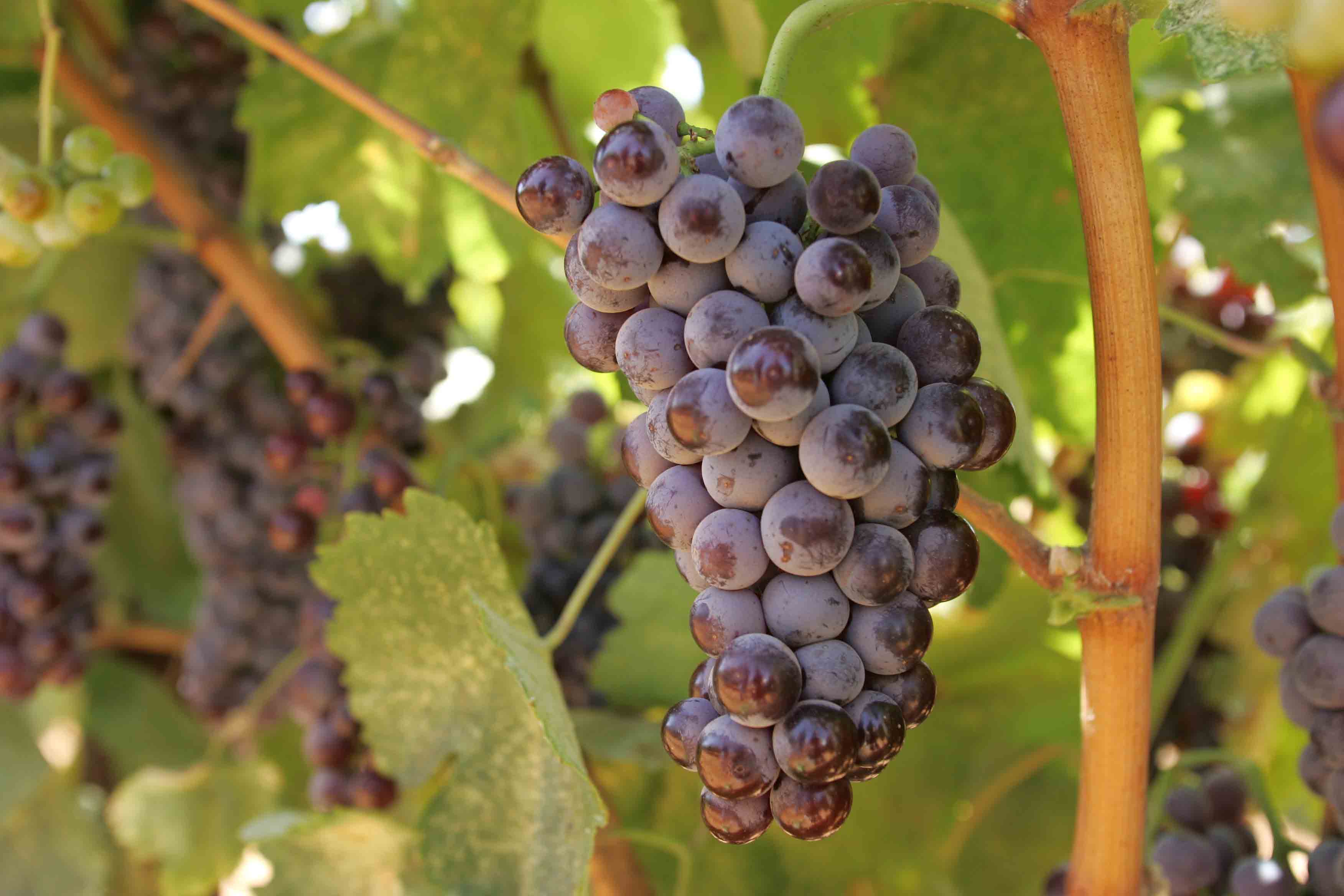
Moschofilero
At a glance
Moschofilero is an aromatic pink-skinned variety planted in the Mantineia plateau of the Peloponnese. Almost all of the Moschofilero grown in Greece (1145 ha/2015 national statistics) is found in this location. There are also some parcels near Tripoli (approx. 100 ha), some in Messinia and some in ancient Olympia (5 ha). Nevertheless, plantings in these areas are an exception. This is because producers in other regions seem to believe that this variety can only shine in the cool climate of Mantineia and thus don’t bother planting it. Although this is probably the case, we can’t be sure as it has not been fully explored outside the broader region of Arcadia and Mantineia.
Moschofilero is a variety that embodies qualities that are pleasing to most consumers. It is aromatic and floral but also very fresh and crispy, a tricky combination as most aromatic varieties are soft on the palate. We are lucky to have a native variety in Greece that is both floral and vibrant on the palate.
It produces wines with a greyish hue (remember it is a pink-skinned variety) with an intense, heady aroma of rose petals, jasmine, lemon blossom, orange zest, pungent spice, and even some minerality. The spicy elements take 2-3 years following the harvest to develop. The wines are crisp, light-bodied and fresh with relatively low alcohol. Apart from the dry whites, it also produces interesting sparkling wines and, increasingly lately, rosé wines.
History -Origins
Synonyms: Fileri, Moschofilero, Fileri Mantineias, Mavrofilero, Fileri Moschato
Αccording to Wine Grapes, it was allegedly mentioned as early as 1601 and is generally used to refer to a group of clones with the same DNA and separate names. These include Asprofilero (white Fileri), Mavrofilero (Black Fileri) and Kokkino Fileri (Red Fileri).
As to its beginnings, opinions are divided. Some believe that Moschofilero is a mutation of Fileri variety (Stavrakakis and Kourakou). Mavrophilero and Xanthofilero are other mutations of the variety (Fileri). But, according to others, Moschofilero and Fileri are two completely different varieties. The second view holds that Moschofilero is the ‘mother’ variety expressed with different clones such as Asprofilero, Xanthofilero and Mavrofilero. Indeed, a puzzle that will need DNA analysis for some light to be shed on the issue. In discussion with Prof. Koundouras from Thessaloniki University, he held that Moschofilero is a dark-skinned variety that gets its colour from its ripening state. ‘When there is a high level of ripening, the colour of the variety is saturated. It becomes black-Mavrophilero, whereas when yields are high, it takes on a pinkish or blonde colour – Asprofilero and Xanthofilero.’
I questioned this with major producers of Moschofilero, and opinions were divided.
‘The intensity of the aromatic characteristics differs significantly between the clones with the floral and fruity character of Moschofilero distinguishing it markedly from Fileri. Moschofilero and Fileri must have a common ancestor. Although no specific research has been carried out on the subject, to the best of my knowledge, I believe that Moschofilero is a clone of Fileri that developed in the separate terroir of Mantineia’, says producer Yiannis Tselepos. ‘Such are the phenotypic similarities that one could hardly support an opposite statement’, agrees George Skouras.
Contrarily, Yiannis Voyiatzis of the historic Boutari winery believes Moschofilero is an altogether different variety. ‘Mavrofilero, Xanthofilero and Asprofilero are considered variations of the Moschofilero variety and may result from mutations. Fileris, on the other hand, are a separate family that share a very high degree of genetic similarity amongst themselves, but differ significantly from Moschofilero and its variants.’
In the vineyard
Moschofilero is a late-ripening variety harvested in late September or even October, depending on the variations of each vintage. It is a vigorous and productive variety, primarily trained on wires, except for some old goblet-shaped vines. Short pruning is necessary because of high bud fertility. Moreover according to Hellenifera, Moschofilero's shoots have an upright growth so it can be grown with reduced training or in a sufficiently open gobelet.
It is planted in clayey, sandy, sandy loam with little CaCO3 content. Yields are generous and can exceed 70hl/ha. In high yielding vineyards, production may be more than 150hl/ha. In the Mantineia zone, the 110 R rootstock is used successfully (90%), but a small percentage is grafted on 41 B (10%) rootstocks. There have been experimental plantings using other rootstocks such as Riparia Gloire de Montpellier, 101-14 Mgt, 161-49 C etc., to promote ripeness and avoid late harvest during the September rains.
It is generally considered to be resistant to powdery and downy mildew. Still, it is susceptible to botrytis bunch rot, which is the main challenge in a late-ripening zone such as Mantineia that experiences prolonged rainfalls during harvest. It buds in the last ten days of March, flowers in the 2nd ten days of May, and is harvested towards the end of September up to the 2nd ten days of October.
Ampelography
Medium-large cylindrical-conic, bunches of medium density with a pinkish colour, with a moderately long greenish-white peduncle. The berry is medium-sized, spherical, thick-skinned, with very low anthocyanins. The leaf is developed, large, circular to slightly cuneate, with three lobes. Each bunch weighs around 210 gr.
Terroir
The terroir influences the variety greatly. George Skouras argues that it is the ultimate terroir-driven variety. ‘Wherever it was planted (except Mantineia), it did not succeed. Examples such as Mexico, California, Spain and Greece in places. Moschofilero loves and is favoured by the cold climate and high altitude of Mantineia. Outside the zone, it loses its acidity and aromas’, he says. Yiannis Tselepos adds: ‘Factual data suggest that it has quite a different character when grown in other areas, very much like the case of Assyrtiko outside Santorini. As Moschofilero is a late-ripening variety, it needs a cooler continental climate to maintain its aromatic characteristics and acidity. Very few areas in Greece, such as Mantineia or Amyndeo, can offer these climatic conditions.
In fact, the variety was planted in Amyndeo by Boutari winery. Still, it did not progress further. Yiannis Voyiatzis of Boutari says that he knows there are plantings in the highlands of Corinth that are doing very well. ‘In Attica, for example, its quality performance was at least indifferent, relatively zero, a standard wine with nothing to do with the Moschofilero we know’, he continues.
He goes one step further, saying, ‘in Mantineia, there are not many plots with slopes, but this is a factor of differentiation, as of course the soil and the age of the vineyards. In recent years, we have paid particular attention to soil cultivation on the Boutari winery at Mantineia. The vineyards we planted with Mavrofilero a few years ago have given excellent results. Now we are focusing on the potential of some old vineyards, which offer great palate complexity. These old vineyards are well adapted to their terroir. We also recognised significant differences between the wines from different vineyards.’
‘The Mantineia terroir has benefited dramatically from climate change’, comments Dimitris Akrivos from Troupis winery. ‘The rise in the average temperature has brought the harvest date forward, which has resulted in better maturation, healthier grapes and the possibility of producing more styles of wines. Also, the soils of this region, which contain enough sand, offer excellent drainage, both for the showers of earlier times and for the rains of recent years.’
Wine Styles
Moschofilero has many faces. From sparkling wines, dry whites to rosé and even sweet wines.
Sparkling: Traditional method style championed by Tselepos, and Charmat method production by Spyropoulos.
Classic dry white stainless steel fermented: The predominant style is floral, light to medium-bodied with bright acidity. Classic examples include Tselepos, Boutari, Troupis, Skouras, Bosinakis, Moropoulos, Spyropoulos and Semeli.
Gris wines (some are partly oak fermented): to gain more depth and elevate ageing potential. Examples include Tselepos Blanc de Gris, Boutari Terra Grigia and Troupis Route Gris.
Rosé: the style depends on the extraction protocol. It can range from a few hours saignée to 100 days skin contact. Akrivos from Troupis winery says that the rosé Provence-style Moschofileros have an advantage compared to red varieties. Due to their few anthocyanins, one has to extract for several hours to obtain the desired colour. The result is a boost on aromas as well.
No added Sulphur/Natural/skin contact: Examples include Boutari Experimental, Troupis Hoof and Lur, Troupis Ekato.
Sweet wines
Notable Producers of Moschofilero
Boutari, Tselepos, Semeli, Skouras, Spyropoulos, Troupis, Bosinakis, Moropoulos
Ageing Potential
In terms of the ageing potential of Moschofilero, I would say that there is a consensus that classic examples age for 2-4 years following the harvest. George Skouras points out that Moschofilero does not generally have much ageing potential. However he argues ‘That said, we have tried 10 and 15 yrs old Moschofileros and were impressed. These either came from our cellars or other producers. The acidity certainly helps a Moschofilero age, but its aromatic profile can become heady with ageing. Salto proved to be an exception, as it seems to age amazingly well. In all, one could say that the ageing potential of Moschofilero is still an open question to be answered in the long run’, he concludes.
Tselepos, on the other hand, is a firm believer in the dynamics of Moschofileros. ‘For me, the effort to highlight another side of the variety did not start in the present day, but two decades ago with our Mantineia Vareli, which evolved into Blanc de Gris.' Moschofilero, with its high acidity and its significant phenolic concentration, since it is a reddish and not white variety, has the background needed to give wines that could age. Voyiatzis adds to the discussion that for years Boutari has presented their view on the great ageing possibilities of Moschofilero with wines from ’95 and ’96 that evolved amazingly.
Akrivos highlights the promising initial conclusions saying that a variety that can produce wines with a pH of 3.10-3.15 can only age well. Particularly rosés with day extraction show even greater dynamic.
Challenges Ahead
In the vineyard
• Invest in clonal research to better understand the variety.
• Reduce yields. As Moschofilero is a productive variety its production needs to be controlled both with viticultural techniques (strict pruning, zero or minimal fertilisation, green vintage, etc.) and selecting the appropriate rootstock. The choice made in past decades to graft Moschofilero on R110 (resistant to drought) in Mantineia, which has an average of 700mm of rain per year, was made to produce quantity and not quality. A note on the yields' issue, these must not decrease too much as colour increases and aromas become heavier.
• Availability of different clones to achieve the desired result will produce superior quality wines. For example, another clone could be planted to produce rosé wines and another for sparkling wines.
Brand image
• Reinvent its identity. Unfortunately, varieties that have the prefix moscho- (musc-) are immediately considered aromatic, light-bodied, with little complexity.
• Persuade consumers that Mochofilero wines can be serious and attract a broader range of consumers.
Styles
• Highlight the more complex wines and further explore styles such as rosé and skin contact.
Marketing
The wineries of Mantineia need to take collective action, with help from local institutions, to communicate the story of their region, its history, the evolution and the current quality of their wines.
Tselepos outlines the current commercial position of Moschofilero and predicts that it could be the next big thing in the future. ‘Moschofilero has great commercial success abroad as its profile meets the demands of consumers in both Europe and America’ he notes further explaining the challenges.
The misfortune of the variety lies in the fact that its commercial success in Greece preceded the revolution of quality Greek wine. Thus, during the period of its great demand, the producers were absorbed by the production of large volumes for sale, which lacked quality control. Moreover, to meet needs, particularly in the bulk wine category, Moschofileros were degraded producing wines with the addition of other varieties. All of this contributed to a demotion of the variety in the average consumer’s eyes, which was not due to the character of the variety itself, but rather to manipulation of consumers by the producers.
So, today, Moschofilero is not as fashionable as Malagousia. Nevertheless, it may eventually benefit from the time and space it has been given to be cultivated and vinified with the care and respect it deserves by the new generation of Mantineia winemakers.
Perfect Pairing
Moschofilero, in its purest form, is a wine that offers a ‘fresh or zingy’ acidity, ‘floral’, ‘citrus’ notes, ‘low-medium alcohol, and it belongs to the light-weight wines of the world. In other words, it can be offered nicely at the beginning of a meal with a great selection of appetisers or with a light lunch on a warm spring day. My personal favourite is a sea bass ceviche with fresh chives, cracked black pepper and ginger.





